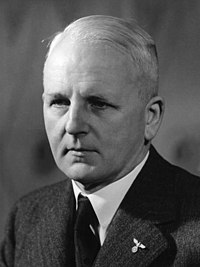Ernst von Weizsäcker
| Ernst von Weizsäcker | |
|---|---|
 |
|
|
Secretary of State at the Foreign Office Germany |
|
|
In office 1938–1943 |
|
| Preceded by | Hans Georg von Mackensen |
| Succeeded by | Gustav Adolf Steengracht von Moyland |
|
Ambassador to the Holy See Germany |
|
|
In office 1943–1945 |
|
| Preceded by | Diego von Bergen |
| Succeeded by | Wolfgang Jaenicke (1954) |
| Personal details | |
| Born | 25 May 1882 Stuttgart |
| Died | 4 August 1951 (aged 69) |
| Nationality | German |
| Military career | |
| Allegiance |
|
| Service/branch |
|
| Years of service | 1900–1920, 1938–1945 |
| Rank |
SS-Brigadeführer Korvettenkapitän |
| Battles/wars |
First World War Second World War |
Ernst von Weizsäcker (25 May 1882 – 4 August 1951) was a German naval officer, diplomat and politician. He served as State Secretary at the Foreign Office of Nazi Germany from 1938 to 1943, and as its Ambassador to the Holy See from 1943 to 1945. He was a member of the prominent Weizsäcker family, and the father of German President Richard von Weizsäcker and physicist and philosopher Carl Friedrich von Weizsäcker.
Weizsäcker was born in 1882 in Stuttgart to Karl Hugo von Weizsäcker, who would become Minister President (Prime Minister) of the Kingdom of Württemberg and raised to personal nobility in 1897, and Paula von Meibom. In 1911 he married Marianne von Graevenitz, who belonged to the old nobility. In 1916 he became a Freiherr (Baron), as his father and his family were raised to the inheritable nobility, less than two years before the fall of the local monarchy.
In 1900, Weizsäcker joined the Kaiserliche Marine (Imperial German Navy) to become an officer, serving mainly in Berlin. In 1916, he served as Flag Lieutenant to Admiral Reinhard Scheer aboard the German flagship SMS Friedrich der Grosse during the Battle of Jutland. In 1917, during the latter portion of World War I he earned the Iron Cross (both classes) and was promoted to Korvettenkapitän (corvette captain) (equivalent to U.K and U.S. naval officer rank of lieutenant commander) the following year. He was a member of the Naval Staff led by Admiral Reinhard Scheer from August 1918. From June 1919 to April 1920, he served as naval attaché to the Hague.
...
Wikipedia
